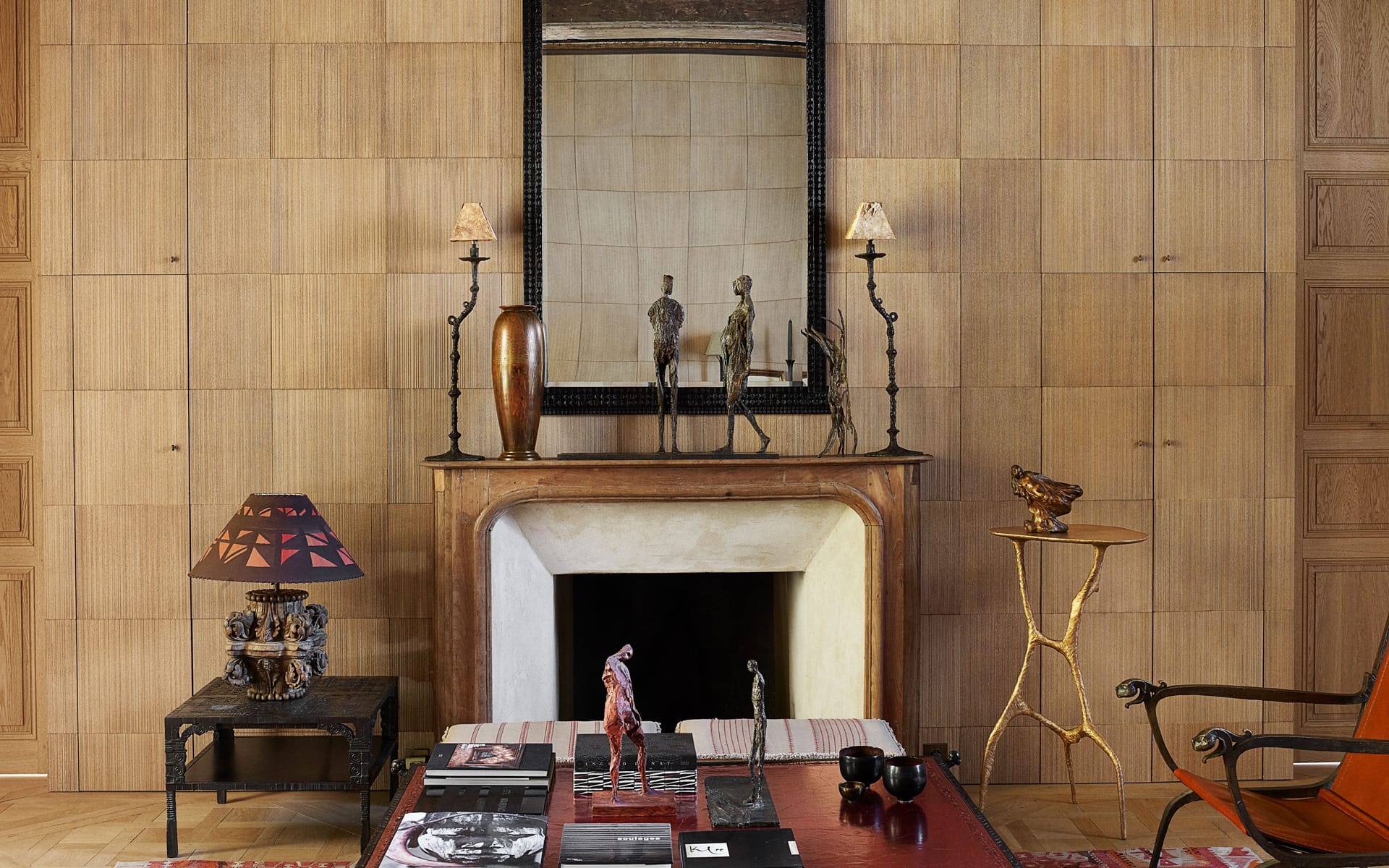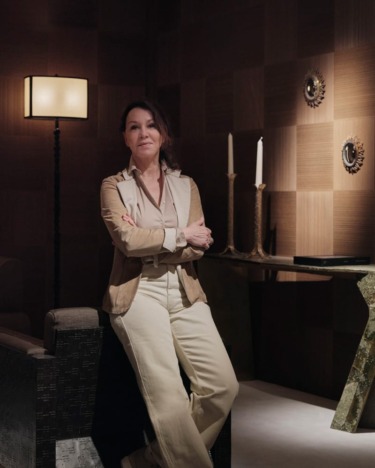Designer Ingrid Donat Opens Her Art-Filled Home in Paris
In a conversation with Galerie, the creative visionary discusses the processes behind her distinct object-making

Opening to fanfare at The European Fine Art Foundation (TEFAF) in New York City, the celebrated Parisian designer Ingrid Donat customized an extraordinary booth for Carpenter’s Workshop Gallery replicating her Paris home’s profound attention to detail. Known for her exquisite furniture and lighting in bronze, her works are sought after by some of the world’s leading interior designers and architects, including Peter Marino and Robert Couturier. Here, she discusses her creative process, her personal connection to the Giacometti brothers, Henri-Cartier Besson, and André Arbus, and how art inspires every aspect of her life.


Galerie: At this year’s TEFAF in New York, the booth you designed for Carpenter’s Workshop Gallery included a new gold patina Commode Skarabée [which translates to “beetle dresser”]. What is the process behind the techniques used to create this piece?
Ingrid Donat: I desired to execute the Commode like a piece of jewelry. I always like bronze when it’s fresh from the foundry; it’s gold but imperfect. However, you can’t keep it in this state because with the air it becomes oxidized and darker. All the weldings are in the same material, and in all my work, I hide the weldings. It’s a challenge to keep the patina and the consistent gold pigmentation. Inside, the two doors unfold like insect wings, hence the name. All surfaces inside and outside of this piece have been sculpted. The Commode’s sculpted clips hinge around the hinge and tuck into the dresser when the doors are opened, and it is also fully carved inside. The interior of the drawers has embossed leather. It was more complex to develop it than the traditional bronze technique.

Galerie: Considering this is the 15th anniversary of Carpenter’s Workshop Gallery, which was co-founded by your son Julien Lombrail, how is this professional milestone reflective of your career and where you look forward to continuing?
Donat: We are a working family, as you may know. I was 40 years old when I started to produce work. We have the most talented craftsmen to work with; everything is viable. All I need are ideas, and they do the rest. It’s expertise. We are very meticulous.
Galerie: What is your approach when starting a piece? Do you sketch first?
Donat: Yes. I do a lot of sketching. I have two studios, one is in Paris, downstairs in my house. I go there daily: we work on drawings, three-dimensional models, research, and development. It is my creative place. The second one is in the Carpenters Workshop in Mitry. We had an engineer figure out how to balance the heavy doors of the Commode to check if the proportions were accurate and to devise a prototype. I then put wax on the prototype panels with my tools and made all these patterns to add warmth to the coldness of the bronze. In Mitry, I work with the best artisans specializing in wax, bronze, chiseling, patina, woodcarving, upholstery, parchment, handmade fabrics, and ligature. The craftsmen enable me to elaborate, push the technique further, and answer considerable challenges. The foundry is outside of Mitry.

Galerie: How do you thread functionality and aestheticism within the setting of a space and the objects you construct? Do you gather information through research, or does it just come from intuition?
Donat: I always create my ideas based on my own home. I begin by doing it for myself. I only do some things for myself, but when I have orders to do a whole place, I look at the site and imagine something I want. I am so lucky because the architects also let me do what I please. My concept is to create a lifestyle.
Galerie: Even the booth you made here in New York, with its linen ceiling, dimmed lights, and the way the candle sticks are arranged. Each moment is distinct, how the table responds to the hand-woven fabric of the silk within the chairs and the painted geometric shapes on the cushion of the bench. Where did you begin creating your artistic universe?
Donat: I have been a sculptor from the beginning, always sculpting portraits for own and my friend’s children. I was friends with Diego Giacometti, and I bought furniture from him, and one day he said, “No, I don’t have anything.” And I have so many orders for other people, I thought, do it yourself. So I started to make my table and decorative elements, such as a bed frame, staircase rail, sconces, etc. Initially, it was only for my personal use.

Galerie: Tell me about your relationship with Diego Giacometti.
Donat: My first husband, the father of my children, is a very big art collector. We were always seeing a lot of artists or galleries. I was close to Italian sculptor Sylva Bernt and her husband, designer André Arbus. Arbus was a significant designer from the 1950s, and they were all in their eighties. I also knew Henri Cartier-Bresson and Giacometti; they were all a gang. I also knew César Baldaccini. I love sculpting and love Alberto Giacometti. Diego shared the studio with Alberto, and visiting his space during this period was stimulating. During this time, he was doing everything for the Museet Picasso in Le Marais, and when I arrived at his home, he was always working. I loved to see him create, but he never wanted to work. He enjoyed drinking coffee with me inside the house when I was there. But I think it’s important to note that my design is unlike Diego’s. He did round sections, while I did square sections. He liked green patina, and I liked dark patina. He did animals, and I focused on the human person. He put glass on it, and I never put glass.

Galerie: Can you shed light on your interest in indigenous art from the scarification of the island of Réunion in the Indian Ocean and how much of an impact this has had on your work.
Donat: My father is from l’île de La Réunion, and my mother is Swedish, and they met at La Sorbonne in Paris. They didn’t stay together and divorced quickly. I grew up in Dalecarlia with my mother, in the middle of Sweden. At nineteen, I met my first husband, and he was already in art, and I was exposed to indigenous arts. I had never seen this work before but instantly gravitated. One day I did my DNA test and discovered I have a significant percentage from Kenya and Eastern Africa. My instant love for Africa made more sense. I am convinced that this multiculturalism has shaped the uniqueness of my art and my creations. I got from Sweden a rigorous taste for well-done things.


Galerie: How does Paris inspire you and your work?
Donat: It’s so beautiful. I am happy to live here in Le Marais. I have a garden that is something very special, and I love to organize long lunches. They start at noon and finish at six or eight o’clock, and we eat again. However, I find inspiration in front of the Atlantic Ocean and the changing colors of the sea. I go from CAP Ferret to Biarritz to the beautiful southwest Atlantic because it’s flatter, unlike the Mediterranean Sea. On the Atlantic, you can also have a storm, and after five minutes, it turns into sunshine, and all the color changes; I feel the best here and most creative. I had a house for a long time, for four years near Bordeaux, and I loved the weather when I visited, always sitting inside on the other side of the window. I like this cold, invigorating, and restless water. The sea inspires me and soothes me.
Galerie: How do you live with art, and how does it inspire you creatively?
Donat: I always live with art and I always find new objects when I travel. I recently bought a headrest made of wood used to put your head on like a pillow from a market. It is essential that everything be art for me. It could be a flower outside or when I’m cooking. In my office, for example, I have a pair of floor lamps I made, on one column is the body of a man and the other is a woman. There is also a sculpture by Sylvia Bernt and a signed photograph Diego Giacometti gave me for my birthday. Also on the shelves are objects from Africa. I have a lampshade I painted—I always paint something if I don’t like it initially. When I started creating work for Barry Friedman’s gallery, he had much older clients, and now their children acquire my furniture. And this, for me, is something because I remember I was not too fond of 1950s Swedish and Danish furniture, and today, it’s so fashionable. I want my work and metier to be timeless, handed down each generation.